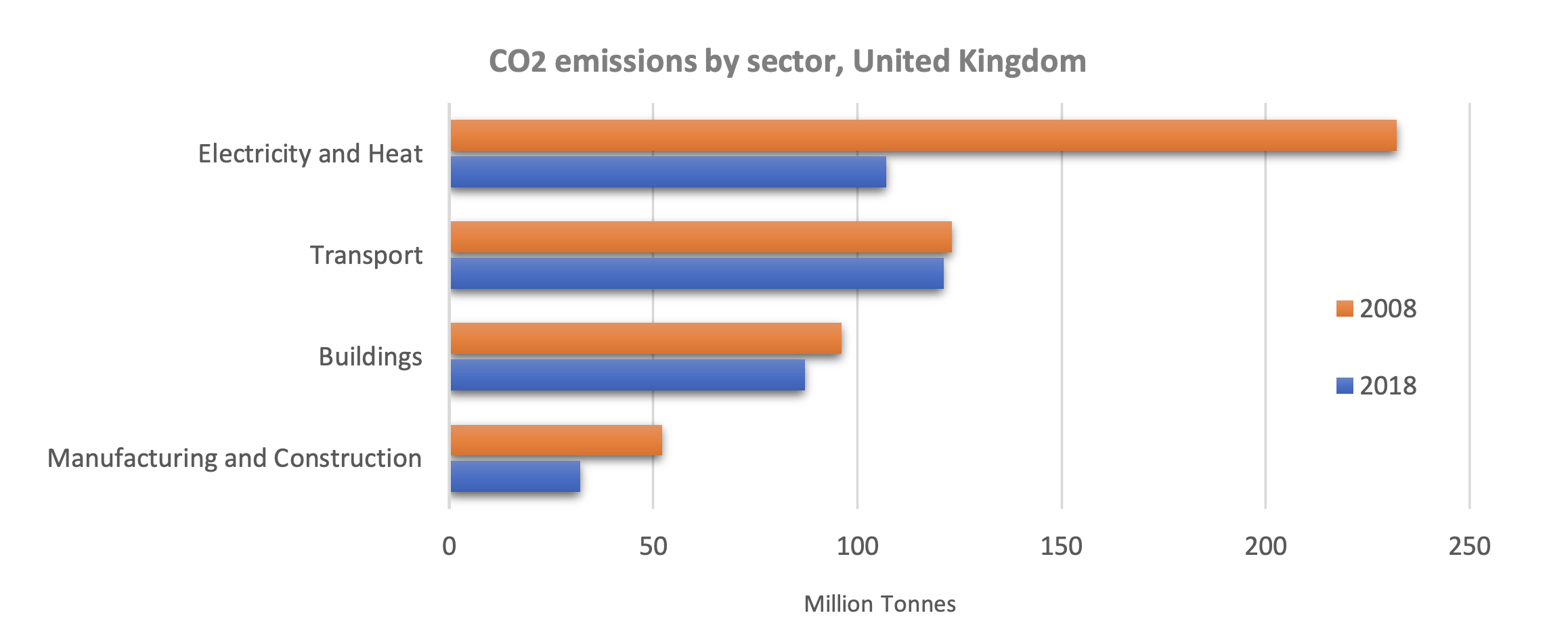Although climate change may have been temporarily knocked off the front pages by the war in Ukraine, the droughts this summer have served to bring the climate issue back in a very real and tangible way. The pressure on everyone to invest in greener technologies has not gone away.
The Top 4 Contributing Sectors
This is especially the case for businesses in the top CO2 contributing sectors: Transport, Electricity and Heat, Building, and Manufacturing. While a 10-year comparison shows these sectors have reduced their emissions from a total of 500m down to 350m tonnes, it is clear there will be increasing policy pressure brought to bear by the UK and European lawmakers as they strive to deliver their carbon budgets on the road to achieving their net-zero pledges.

The transition to greener and more efficient Working Assets
The type of working assets that businesses use in their day-to-day operations will continue to be a major contributing factor in the CO2 equation. Fortunately, we are already seeing a shift by businesses towards greener and more efficient working assets:
For Electricity and Heating, there has been a notable fuel switch from coal to electric and renewables, plus the installation of energy generation assets like CHP biomass systems that enable heavy energy users to generate heat and power in a cheaper and more efficient way.
In the Transport sector, we are seeing hauliers moving their fleets across to electric and hydrogen vehicles, particularly in the last-mile delivery space. Global logistics companies are also investing in electric plane and drone technology as ways to further reduce their CO2 footprints.
Building companies have been adopting better material alternatives for carbon-intensive cement, and buildings are being designed to run in a smarter way, from the use of intelligent LED lighting and solar power generation to shared facilities and cars for residents.
Manufacturers have been running energy audits to “green-clean” the old assets in their production lines, plus the rapid emergence of IoT and Industry 4.0 technology has seen old machines replaced with new automated assets that are cheaper and cleaner to run.
Action will speak louder than words
Businesses are acutely aware of the importance not only at a policy level but also the impact that “going green” has on their standing with the investor and banking markets. The greener the business, the more attractive it is to be involved. No surprises then that the IFRS Foundation has recently announced they plan to establish a measurable ESG rating for listed companies to disclose in their annual reports. The new rating method will provide investors with a factual and comparable basis for understanding how companies are responding to ESG issues, like climate, to help better inform their investment decisions.
In practical terms, this means that greenwashing will no longer do, and listed companies will need to put their money where their ESG mouth is.
The catch-22
The problem, however, is that investing in new green assets costs money and can be a big drain on a company’s capital reserves. On one hand, the ESG improvement is investor-attractive; however, on the other hand, the resulting capital depletion can be a turn-off to investors seeking returns. Investors want to invest in green but not necessarily if it hits their wallets. Instead of using their own cash, the companies could choose to take out more debt or leasing to pay for the assets; however, the financial liability impact on their balance sheets can cause knock-on problems in other areas.
Take the example of a large global brewery that wants to switch to renewable energy by installing solar and CHP biomass systems into their factories. This could be seen as an attractive move by the investor community; however, the brewery may already be under pressure from their bank and ratings agencies to avoid any large and balance sheet-leveraging transactions. While the ESG investment could make sound financial sense, the company may simply not have the balance sheet headroom to go ahead.
We have the answer
Our Asset-as-a-Service solution allows companies to source new green assets in a way that doesn’t impact their capital reserves or put pressure on their balance sheets.
We pay for the assets and hold them on our balance sheet instead, and then simply provide the assets for the company’s use.Our usage agreements do not require the companies to sign up to a minimum payment obligation so we take a true business risk and not just a financial one.
Importantly the assets do not become a financial liability on the company balance sheet which might otherwise have sent the wrong signals to their investors and banks.
If you are considering replacing old with new green working assets but are struggling to find the financial headroom then get in touch to find out more.
Please contact our team to learn more.
Lee Thompson at [email protected]
Jay Johnson at [email protected]
This article has been prepared solely for information purposes and the opinions expressed and set out herein are illustrative only. Please note that any content in this article is based upon Falcon’s own views and opinions and should not be relied upon by the reader as advice. Falcon shall not be liable for losses arising out of reliance on this article.
